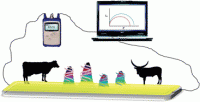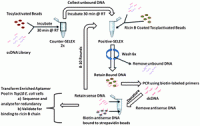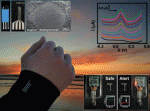This paper presents an electrochemical way of discriminating between the DNA of different bovine species. It targets the mitochondrial Cox-1 gene which is considered to be a standard ‘barcode sequence’, having low variation within species but high degrees of variation between taxa. The benefit of targeting mitochondrial DNA is that each cell will have hundreds to thousands of copies, facilitating the use of very small samples.
Electrochemical impedance spectroscopy is central to the method and was used to probe for charge resistance transfer differences due to mismatched DNA. Zinc ions were added when DNA hybrids (matched or mismatched) formed on the gold electrode surface, expediting charge transfer to the solution phase redox probe. The zinc ions effectively adjust the charge transfer in situations where complementary sequences exist. It is therefore possible to use charge resistance transfer differences to tell if the correct DNA had been captured. The authors also carried out a dehybridization study to show if the sensor could be reused.
Find out more by reading the article for free until 4th October.
Electrochemical identification of artificial oligonucleotides related to bovine species. Potential for identification of species based on mismatches in the mitochondrial cytochrome C1 oxidase gene
Mohtashim Hassan Shamsi and Heinz-Bernhard Kraatz
Analyst
DOI: 10.1039/C1AN15414A
Recap on some related papers below…
The effects of oligonucleotide overhangs on the surface hybridization in DNA films: an impedance study
Mohtashim Hassan Shamsi and Heinz-Bernhard Kraatz
Analyst, 2011, 136, 3107-3112
DOI: 10.1039/C1AN15253J
Probing nucleobase mismatch variations by electrochemical techniques: exploring the effects of position and nature of the single-nucleotide mismatch
Mohtashim H. Shamsi and Heinz-Bernhard Kraatz
Analyst, 2010, 135, 2280-2285
DOI: 10.1039/C0AN00184H
Enzymatically modified peptide surfaces: towards general electrochemical sensor platform for protein kinase catalyzed phosphorylations
Sanela Martic, Mahmoud Labib and Heinz-Bernhard Kraatz
Analyst, 2011, 136, 107-112
DOI: 10.1039/C0AN00438C




















